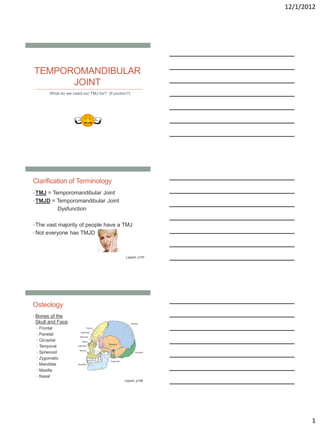
Tmj3slides
- 1. 12/1/2012 TEMPOROMANDIBULAR JOINT What do we need our TMJ for? (Function?) Clarification of Terminology • TMJ = Temporomandibular Joint • TMJD = Temporomandibular Joint Dysfunction • The vast majority of people have a TMJ • Not everyone has TMJD Lippert, p197 Osteology • Bones of the Skull and Face: • Frontal • Parietal • Occipital • Temporal • Sphenoid • Zygomatic • Mandible • Maxilla • Nasal Lippert, p198 1
- 2. 12/1/2012 Osteology of the TMJ • The TMJ is located ___________ to the ear • The TMJ is an articulation between the articular fossa of the ______________ bone of the skull & the condyle of the mandible Lippert, p197 Osteology continued… • The skull has 2 parts: • The bones of the large cranium cavity, which encase the brain • The bones of the face • The TMJ is an articulation between one facial bone (the mandible) and one cranial bone (the temporal bone) Lippert, p198 Osteology continued… • The Mandible: • Shaped kind-of like a horseshoe • Often referred to as “the jaw” • Articulates with the temporal bone on each side of the face forming TWO IDENTICAL joints on either side of the face Lippert, p198 2
- 3. 12/1/2012 Osteology continued… • The Temporal Bone: • Where is it? • Articular fossa • Mastoid process • Articular Tubercle • External auditory meatus • Styloid process • Zygomatic process Articular Tubercle Lippert, p199 Osteology continued… • The Hyoid Bone: • Horseshoe shaped bone • Lies just superior to the thyroid cartilage at the level of C3 • It has NO BONY ARTICULATION!!! • It is suspended from the styloid process of the temporal bone by the stylohyoid ligament • Main Function: attachment site for tongue muscles and muscles that open/close the jaw Lippert, p201 3
- 4. 12/1/2012 Osteology continued… • Thyroid Cartilage: • The largest of the 9 cartilages of the larynx • Commonly called the “Adam’s apple” • More prominent in males • Lies just inferior to the hyoid bone at the level of C3 – C4 Lippert, p201 TMJ Structure • Synovial Joint with a Hinge-like shape (not a pure hinge joint because it allows some gliding motion) • Consists of: • 2 bones • A disk that divides the joint into 2 spaces • A joint capsule • 4 ligaments • 4 main muscles that create 5 motions Lippert, p197 TMJ Movement • Osteokinematics: • Depression • Elevation • Lateral deviation • Protrusion • Retrusion Lippert, p198 4
- 5. 12/1/2012 TMJ Movement continued… • Arthrokinematics: • Depression: involves two motions. First, the mandibular condyle rotates anteriorly on the disk. Second, the condyle and the disk both glide anteriorly and inferiorly over the articular tubercle of the temporal bone • Elevation: the reverse action of depression • Protrusion and Retrusion: no rotation occurs, the mandible moves either anteriorly or posteriorly in the transverse plane. The mandibular condyle and disk move as one unit against the articular fossa of the temporal bone • Lateral deviation: occurs in the transverse plane. To move the mandible to the left, the left condyle rotates around a vertical axis and the right condyle glides anteriorly. The opposite occurs to deviate to the right. Lippert, p202 Disc Condyle •During opening of the mouth, the condyles of the mandible move forward along the articular disc. •This is a smooth movement unless the opening is excessive. •Repeated excessive opening can cause trauma to the area and potential disc injury. Lippert, p202 The condyle of the mandible is seated in the mandibular fossa of the temporal bone. The lips are closed and the teeth are several millimeters apart. Lippert, p198 5
- 6. 12/1/2012 This would be maintained by low levels of activity of the temporalis muscles You should be able to open your mouth enough to fit 23 finger widths between the front upper and lower teeth. Lippert, p198 What motion is she performing with her mandible? TMJ Supporting Structures • Articular Disk • Joint Capsule • Four ligaments • The Lateral Ligament (aka temporomandibular ligament) • Sphenomandibular Ligament • Stylomandibular Ligament • Stylohyoid Ligament Lippert, p201 TMJ Myology • The four PRIME MOVERS of the TMJ are (all of which are innervated by the Trigeminal Nerve, CN 5): • Temporalis • Masseter • Medial Pterygoid • Lateral Pterygoid • Unless otherwise stated, the action of these muscles is considered to be BILATERAL and occurs at each joint (right and left) simultaneously. Lippert, p203 6
- 7. 12/1/2012 Please identify the following muscle: Temporalis Location Origin: Temporal Fossa Insertion: Coronoid Process and ramus of mandible Action Bilateral: elevation of the mandible (closing the mouth), retrusion of the mandible Unilateral: ipsilateral lateral deviation Innervation Trigmeninal nerve (Cranial n. V) Palpate it on yourself! Lippert, p204 Please identify the following muscle: Masseter Location Between the zygomatic arch of the temporal bone and the mandible Action Bilateral: elevation of the mandible (closing the mouth) Unilateral: ipsilateral lateral deviation Innervation Trigmeninal nerve (Cranial n. V) Palpate it on yourself! Lippert, p204 Please identify the following muscles: Medial Pterygoids (the p is silent) Location Internal angle of ramus of mandible Action Bilateral: elevation of the mandible (closing the mouth) & protrusion of the mandible Unilateral: contralateral lateral deviation Innervation Trigmeninal nerve (Cranial n. V) Lippert, p204 7
- 8. 12/1/2012 Please identify the following muscles: Lateral Pterygoids Location Inside the mouth near the condyle of the mandible Action Bilateral: depression of the mandible (opening the mouth) & Protrusion of the mandible Unilateral: contralateral lateral deviation Innervation Trigmeninal nerve (Cranial n. V) Lippert, p205 TMJ Myology continued… • The muscles that ASSIST with TMJ movement are: Suprahyoid Muscles Infrahyoid Muscles Mylohyoid Sternohyoid Geniohyoid Sternothyroid Stylohyoid Thyrohyoid Digastric Omohyoid Lippert, p205-206 Common Pathology • Temporomandibular Joint Dysfunction (TMJD) 8
- 9. 12/1/2012 References • Lippert, L.S. (2011). Clinical Kinesiology and Anatomy, 5th ed. Philadelphia, PA: F.A. Davis. 9
